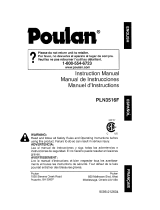
• Donotoperateachainsawthatisdamaged,improperly
adjusted,ornotcompletelyandsecurelyassembled.Be
surethatthesaw'schainstopsmovingwhenthetrigger
isreleased.
• Useextremecautionwhencuttingsmall-sizedbrush
andsaplingsbecauseslendermaterialmaycatchthe
chainsawandwhiptowardsyouorcauseyouto lose
control.
• Whencuttingalimbthatisundertension,bealertfor
springbacksothatyouwillnotbestruckwhentheten-
sioninthewoodfibersisreleased
• Donotcutthroughnails,rodsinthetree,railroadtiesor
pallets.Inspectatreethatyouaregoingtocutforfor-
eignobjectsthatcouldcauseinjuryordamageto your
chainsaw.
• Afterstrikingaforeignobject,stopthemotorandthor-
oughlyinspectfordamage.Repairasnecessary.
• Wedonotrecommendusingthechainsawinatreeor
onaladder.
MAINTAIN YOUR SAW IN GOOD
WORKING ORDER
• All chain saw service, other than the items listed in this
instruction manual maintenance instructions, should be
performed by a Sears or other qualified service dealer.
• Make sure all fasteners are in place and secure.
• Unauthorized replacement parts or the removal of safety
devices may cause damage to the unit and possible
injury to the operator or bystanders. Use only Craftsman
accessories and replacement parts as recommended.
Never modify your saw.
• When not in use, saw should be stored in a dry, highly
secure location away from children.
• All chain saw service, other that the items listed in this
instruction manual maintenance instructions, should be
performed by a Sears or other qualified service dealer.
• Use the right tool. Only use this chain saw for its intend-
ed purpose, to cut wood.
• Do not overreach. Always keep proper footing and bal-
ance.
• Always hold the unit with both hands when operating.
Keep a firm grip on all handles or grips.
• Apply chain brake prior to any repositioning of the oper-
ator in the cutting area. As an additional safety precau-
tion, apply the chain brake prior to setting down the
saw.
• Never touch the chain or attempt to service the saw
while the motor is running. Make sure all moving parts
have stopped. Allow the chain saw to cool, as the chain
can be hot.
• Check the bar and chain at frequent intervals for proper
adjustment. Make sure the bar and chain are properly
tightened and sharpened. Visually inspect for damage.
Repair any damage before restarting or operating the
chain saw.
WARNING: KICKBACKmay
occur when the nose
or tip of the guide bar touches an object, or
when the wood closes in and pinches the saw
chain in the cut. Tip contact in some cases
may cause a lightning-fast reverse reaction,
kicking the guide bar up and back towards
the operator. Pinching the saw chain along the
top of the guide bar may push the guide bar
rapidly back toward the operator. Either of
these reactions may cause you to lose control
of the saw, which could result in serious per-
sonal injury.
Do not rely exclusively upon the safety
devices built into your saw. As a chain saw
user, you should take several steps to keep
your cutting jobs free from accident or injury.
KICKBACK SAFETY PRECAUTIONS
With a basic understanding of kickback, you can reduce
or eliminate the element of surprise. Sudden surprise
contributes to accidents. Be alert to the potential for
kickback at all times.
Keep a good firm grip on the saw with both hands, the
right hand on the rear handle and the left hand on the
front handle, when the motor is running. Use a firm grip
with thumbs and fingers encircling the chain saw han-
dles. A firm grip will help you reduce kickback and main-
tain control of the saw. Don't let go.
Make sure that the area in which you are cutting is free
from obstructions. Do not let the nose of the guide bar
contact a log, branch, fence, or any other obstruction
that could be hit while you are operating the saw.
Always cut with the motor running at full speed. Fully
squeeze the trigger and maintain a steady cutting
speed.
Use only the correct original equipment manufacturer
replacement bars, chains and other parts and acces-
sories. These are available from a Sears or other quali-
fied service dealer. Use of any unauthorized parts or
accessories could lead to serious injury to the user, or
damage to the unit, and will void your warranty.
Follow the manufacturer's sharpening and maintenance
instructions for the saw chain.
• Use only the replacement guide bars and low kickback
chains specified for your saw to avoid injury.
• Watch for shifting logs or other forces that could pinch
or fall into chain.
• Always have saw at full speed when entering a previous
cut. Always use caution when entering a previous cut.
• Do not start a cut using the tip of the saw.




















